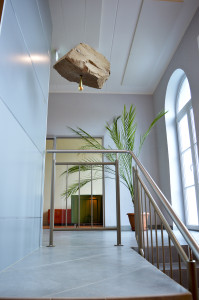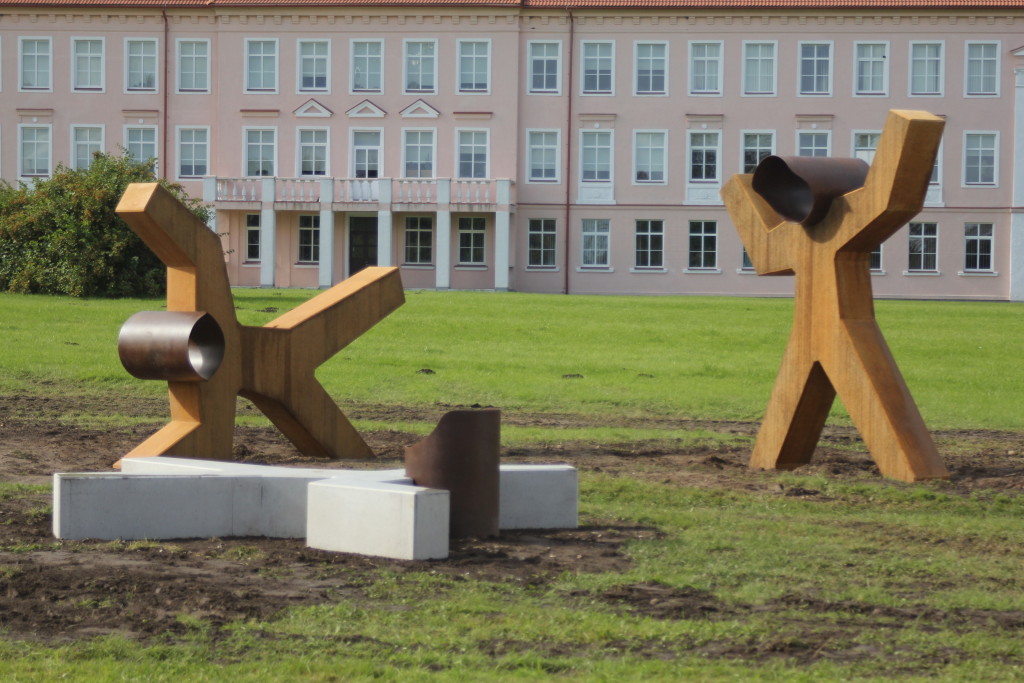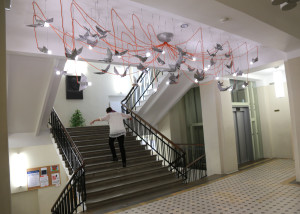The Commissioning of Artworks Act (CAA), also known as the ‘percentage act’, which regulates the commissioning of artworks for new public buildings or public buildings being renovated, took effect in Estonia in 2011. According to the act, 1% of the cost of construction is designated for commissioning artworks, thus enriching the public space with art.
In four years, 25 artworks have been commissioned by various institutions, including the Vocational Education Centre, health organisations and schools; most competitions were organised by State Real Estate Ltd (SRE), through which art has mainly been commissioned for educational institutions. The costs have varied from 7000 euros to the maximum of 65 000 euros. The commissioned art includes exterior sculptures, installations, paintings and photography. The state monitoring is carried out by the Ministry of Culture.
Raul Järg, architect, head of the Estonian Centre of Architecture, sculptural group PeaAsi (the main thing/ the head thing)
In Järvamaa K Vocational Education Centre
Experience as an artist
Our sculptural group PeaAsi (by Priit Pent, Raul Järg and Raul Erdel) was among the first objects made as a result of the Commissioning of Artworks Act. It was quite an inspiring experience. We were very happy with our sculpture and managed to keep it within the budget. The attitude from the commissioning people was constructive and understanding. Deadlines had to be shifted a little bit, but then not everything goes according to plan. In such undertakings, you must be both the artist and the project manager. An old classical pattern emerged, where the architect was the master builder as well as the designer. We designed and carried out the project ourselves. The sculptural group PeaAsi occasionally turns a somersault: sometimes there is a head above a head, or the head can be stuck between the legs. We want to indicate that it is essential to pay attention to the ‘main/head thing’ and define what it actually is, encouraging young people to think about it. It is interesting to know how a work of art continues its life in a new place. When the architect is no longer there to explain things, does the sculpture evoke excitement and ideas? We discussed with the school how the sculptural group could be used in their visual identity.
On the other hand, there are several items in the competition conditions that make artists face strong dilemmas. For example, something truly splendid can turn out to be more expensive than planned. What to do then? One answer is to try to economise, and somehow do it. Depending on the object, it is not always possible to predict production.
Documents necessary for competition
The necessary documents for competition were not a problem for us, because as architects we are used to dealing with public procurement papers. An altogether different experience was the project of the Ida-Viru central hospital, where the commissioner was extremely unprofessional, and the terms and conditions were so confusing that it was almost impossible to tender an offer. We were used to bureaucracy, but still struggled to understand what was actually needed: a simple process can be presented in a very complicated manner. Besides, the way they handled the whole process was totally inadequate. The competition consisted of several parts, and we were awarded the outside sculpture. And then we were essentially disqualified because we did not have a certificate regarding local taxes [other competitors were also disqualified for the same reason – Ed.]. We consulted lawyers and it turned out that they could have qualified us and we could have submitted the document afterwards. They obviously used this excuse so that they would not have to commission this work, to save money etc. We took the matter to the disputes committee of the public procurement office and unfortunately we lost the battle in this bureaucracy. This was a negative experience. We have not been involved in any competition projects since then.
Integration of art or the thing in itself
It is wise to approach an art commission carefully, when the building is still being planned and designed. When everything is ready, it is too late to figure out where to hang a picture. It is sensible to create integration between the building, the interior and the author of the artwork. The architect, sculptor and designer all have the interdisciplinary training to take part in such competitions. There should be more trust in architects and interior decorators. Should a competition really be so independent that the architect and interior architect are basically excluded? At the moment, they can only take part in anonymous general competitions. A line has been drawn in the competition format and a conscious connection, the cooperation between the architect and the author of the idea, cannot be made.
It is good from time to time to produce something independently. For example, in the small town of Paide, we as artists were independent and our cooperation with an architect did not influence our work. This works with smaller objects. With bigger objects (such as the Ida-Viru hospital), where the sum to be spent is huge, the commission is split into pieces and then trouble looms. The problem is that all commissioned works are separate, and there is no integration. I think that in large-scale projects the initial cooperation between the architect and the interior architect or landscape architect yields a more integrated result. The commissioning format is quite rigid at the moment. Perhaps people are afraid that the commission will be messed up in some way. The artists and the architects have to do some convincing in order to bring about any changes.
Commissioning artworks should be more flexible. Today, art commissioning is separate, without understanding why it is being done. I am here reminded of the true story of how white people built an airbase on the island of Kurrunurruvuti in the middle of nowhere. The natives were enthralled that iron birds landed and took off. They watched with fascination how people waved sticks around and wore helmets. At some point, the white people packed up their airbase and flew away. The natives were disappointed. As they had watched carefully what the whites had been doing, they made helmets for themselves, found some sticks and made the same movements, waving the sticks and their arms around. The natives could not understand why the birds failed to materialise. This is what happens when you separate form and content.
Competition terms

Per William Petersen.
XO Kiviõli. Virumaa College of the Tallinn University of Technology, Oil Shale Competence Center, Kohtla- Järve
Architects have a rather good tradition of compiling the terms and conditions for a competition. I have no idea who compiles them in commissioning artworks. In the case of Järvamaa and Ida-Viru, the terms were not compiled by the Artists’ Association, but by a consultant. Paide had a professional consultant who had provided architectural competitions with terms before. The Ida-Viru case was an example of unprofessional terms: the institution that commissioned the work threw them together itself, and made a mess of it. The Artists’ Association should work together with the commissioning institutions and make an effort to work out these terms itself. If the association can’t or won’t, it should cooperate with the Union of Estonian Architects, who can help put such terms together. This would certainly mean some extra resources, but would also help to avoid all manner of misunderstandings and also save the time of professional people. There are several ways to economise in bureaucracy as well. Now, everybody who tenders an offer must immediately present all of the paperwork. As far as I know, this is not actually obligatory. The law stipulates that only the winner has to do this. There is no need to be stricter than the existing legislation: we can organise things much better ourselves, using people’s knowhow. Some people often try to do everything themselves and the result is uncomfortable for both the client and the artist. It may seem that the competition is too bureaucratic, and many never try again. The Artists’ Association could make sure that the competition terms and conditions are professional.
The client and the jury
The jury, of course, has the decisive role. The client matters too, as he, after all, needs to work within limitations and his task in this process is to describe his requirements. In that sense, art is naturally more abstract, because it is not linked to requirements and can be more taste-based. Architectural decisions are not usually taste-based; there are very specific principles which lead to decisions and they can be verified. Artistic decisions rely on artistic taste and contemporary art education. Environmental awareness in a broader sense is fairly low. We live in an open society. Although I feel that architecture has been pushed into the background, I still value the freedom we can enjoy. There are societies where you are not allowed to express your opinion, and if you do it might have a fatal result. In both architecture and visual arts, we are not in the position we would like to be in. The Centre of Architecture aims to reconquer or explain that position. If we are not satisfied with the situation we are in, we must make an effort to make ourselves visible. I think people on the whole do want to be more aware of art and the environment. Society needs to be constantly educated as far as space is concerned.
The meaning of law for an architect
For an architect who designs a building, commissioning an artwork is a way to give additional value to the building. It often happens that towards the end of the construction work, there is an increasing need to cut back and even cancel various things. We are not yet in a situation where construction projects and procurements are properly compiled. One reason is that an architect has no time to work on a project thoroughly. The whole designing context is not perfect either: the landscape architecture is always the last to be completed, and it usually gets the least money. The same goes for the things to be hung on the walls or the installations in the garden. The Commissioning of Artworks Act guarantees added value to a building. I think the architect would be happy if the process were not like a meteorite that simply crashed into your back garden; it should be more well-managed and directed. However, for an architect who has sat on a meteorite, it is certainly an exciting and inspiring experience, an opportunity for excellent creative freedom. When you make buildings, you get caught up in extremely practical matters.
Comments on the Commissioning of Artworks Act
Maria-Kristiina Soomre, art adviser, Estonian Ministry of Culture
Is CAA working? What are the shortcomings? What should be developed and improved?
The Act is working pretty well. The first procurements revealed some major problems, but now all sides have acquired more experience, and the cooperation between artists and clients is smoother. Due to initial shortcomings, the act was considerably amended in 2014; the version in force since 2 February 2015 should be much clearer to all sides and more consistently interpreted.
The most debated issue so far has been clients’ wish to commission inventory and pass it off as ‘art’ (because even the most insipid construction calculators have learned that ‘everything is art’); the new wording more clearly defines art. According to the current act, art is primarily the author’s site-specific original work which has no decisive effect on the functioning of the building (an artwork cannot provide lighting or heating of a room or replace essential furniture, although artworks can certainly have functional and interactive elements which respond to the needs of the user and the room). Clients need more information about visual identity: an artwork for a public space is not meant to advertise the client’s logo or mascot; an artwork can be a landmark, but what should mostly strike the viewer and produce an emotional reaction are the fruits of free creation.
Mari Emmus, State Real Estate Ltd
As a representative of RKAS, what is your experience with commissioning artworks? What role does RKAS play?
State Real Estate Ltd (RKAS), as a state-owned company, has to follow CAA very closely. RKAS has announced and completed nine idea competitions, and one is currently underway. We plan to announce seven competitions this year.
Although we have good experience in organising procurements, we often seek help from the Ministry of Culture, professional associations and art experts in order to learn more about the specifics of the art field. It is probably impossible to harmonise the commissioning of art with norms and standards: it is more like a tailored suit. It is also clear that good things are not born without cooperation and asking questions. We therefore encourage competition participants to ask us questions if something is confusing, and also to make suggestions about how to supplement or simplify the competition documents.
On the basis of realised procurements, RKAS can summarise the process as follows: good things take time and quality is ensured by close communication between all of those involved. There should be more discussion of the fact that good art is not mediocre and liked by everybody.
RKAS is delighted to say that artists who have taken part in a competition return for future competions: they overcome their initial fear that the competition ‘paperwork’ is too complicated.
Has RKAS participated in compiling the competition terms?
When the Ministry of Culture was putting together the new CAA, they asked for RKAS’s feedback. The ministry took some of our suggestions into consideration for the new act.
What could be a new direction in commissioning artworks?
From 1 February this year, an art competition where a jury selects the best work no longer involves a procurement. From now on, competitions will be organised only according to the Commissioning of Artworks Act. I think the commissioning of artworks is moving in the right direction: towards cooperation. Involving creative associations and experts before a competition assures the client that art commissioned for a public space is aesthetically enriching.
Merike Estna, artist, project ‘Sphere’ in Viljandi Riigigümnaasium
I participated in the competition to provide the Viljandi Riigigümnaasium with artworks because I found the building by the Salto Architects highly inspiring. The idea of having an artwork with parts inside and parts outside appealed to me too.
When I worked on the project, I relied on the building itself and its function. The most tense factor in the whole process was time. Deadlines loomed and I just hope that in future such projects will be afforded more time. I realised the project together with the Temnikova & Kasela gallery, who were a great help; Salto and the Viljandi school were also very pleasant to work with.
Ülle Luisk, headmistress of Viljandi Riigigümnaasium (secondary school)
Are you and the others at the school satisfied with Merike Estna’s paintings and sculpture group Sphere? Do they inspire you?
Merike Estna’s works are partly inside and partly outside of our school. Of the four monumental paintings inside, two add
bright colours and two others allow one’s thoughts to flow peacefully. These works are part of our school. The two paintings focusing on colour in the centre of the building create a relaxed mood, which is important because right underneath is the area where students can lie down on cushions and read or study.
Is the art commissioning process yielding the desired results?
After the first experience of commissioning, some ideas for changes emerged, and as far as I know they have already been implemented. It is crucial in commissioning art to perceive and know the real environment where the artwork will be displayed. Decision-making is definitely teamwork. The ideas of the artist, art historian and client together produce a good result. One side must not dominate.
Have the concrete spheres outside been painted?
Yes. These colourful spheres are really lively. They already have a role in the traditions of our school: on ‘refreshing day’, the first-year students wash them, and we have photographed our teacher at these spheres.
See more: www.kul.ee/et/galeriid/kunstiteoste-tellimise-seaduse-raames-tellitud-kunstiteosed




